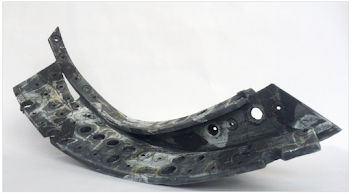One of the first presentations from this lecture series was delivered by ceramist Rebecca Appleby, who tries to apply the concept of Ikigai to her process of working as well as her observations of man made structures and their development over time through the natural affects of the environment they were placed in due to the different aging occurrences for different materials.
Firstly Ikigai as a concept is a Japanese concept meaning "a reason for being". Everyone, according to the Japanese, has an Ikigai. Finding it requires a deep and often lengthy search of self. Such a search is regarded as being very important, since it is believed that discovery of ones Ikigai brings satisfaction and meaning to life. For Rebecca applying this to her professional work after graduating came about in the concepts of her first series of works that aimed to look into the cycles of orders and chaos through the passage of time with organic vs man-made objects and structures. "Life is pure imperfection, as the philosophy of wabi-sabi teaches us, and the passage of time shows us that everything is fleeting, but if you have a clear sense of your Ikigai, each moment will hold so many possibilities." Rebeca believed that order and chaos are eternally linked. That Chaos is a place where everything is complex and unpredictable where as order is where things are so rigid that it's repetitive and restrictive and only by navigating between the two, it is possible to find a meaningful place where you're partly stabilised and partly curious. This experimentation and discovery during her work process led to her first series 'Urban Palimpsest' being presented at Ceramic Art York 2015 where she was able to make new contacts, build networks as well as her own public profile, finalising in her work being used o the cover and advertising material for the following years show in 2016.
To get a more in-depth view of how she goes about her work process to develop pieces and series' such as the aforementioned one, Rebecca followed up with a step by step description of her commonly used work flow from concept of idea to finished process.
The first stage begins with research, both observational and literal. Looking into the ideas and philosophies that were connected in some tangible way to the initial ideas she was having for her work, going on to photograph and document an exploration of interesting form and surfaces, in this case looking at the connection between organic nature on man-made structures.
Seeing how rainwater had affected the structure over time leading to both textural change on the surface and discolouration whilst man made changes had occurred through graffiti with each piece of spray paint telling a story off a moment in time.
The next stage was to take this research and develop it through wok within a sketchbook. Even as a ceramist Rebecca still relies on the creative outlet a sketchbook can provide, from maintaining a sense of creative output to being able to initiate instant mark making in response to thoughts, ideas and observations which can lead to serendipitous reactions and further personal research through experimentation of drawing form and surface. The products of the sketchbook work is imperative to Rebecca as these can often lead to 2d creations that are presented alongside the 3d works to give a greater sense of what her work is trying to convey to the viewer, whilst also increasing accessibility to her work for those who wish to purchase some of her work in 2d format rather than buying an often enormous and expensive unique structure.
During the third stages these initial sketches are pushed forward through a mixture of drawings, paintings and collages, allowing the art of experimentation to really flow through her process keeping that balance between order and chaos. Just responding to her own thoughts on previous photographs and research with no real aim for what a final piece should look like allowing for a more natural response and thus more organic final conclusion, without the rigidity of order and the aim of finding what a final piece should be you open yourself to finding a new and unique result of what the finished product could be.
With the final stag being translating these ideas into design, this process has allowed Rebeca to achieve great success over the years from winning Ceramics Art London 2016's 'Best Newcomer' as well as allowing herself to develop new and unique styles for each subsequent series of works through never relying on the order of knowing what made her successful previously, yet still having a unifying style that helps her stand out.
 |
| Urban Palimpsest (2015) |
 |
| Inner Order (2017) |
 |
| Infrastructure (2021) |
This use of exploration though mark making is something I am acutely aware of having previously graduated as an Illustrator, and is something I have now started to implement into my process even if I am currently working mainly on narrative design, allowing myself to sketch ideas of what characters and places could look like without forcing myself to stick to stereotypes or my knowledge of what designs have worked before and simply asking the question "what if . . ." during the process opens me up to transforming my work from the mundane or sensible and standard to experimental and outlandish where new and unique designs can become realised. With some of my current sketchbook work of lizardfolk and aztec themes below.















No comments:
Post a Comment